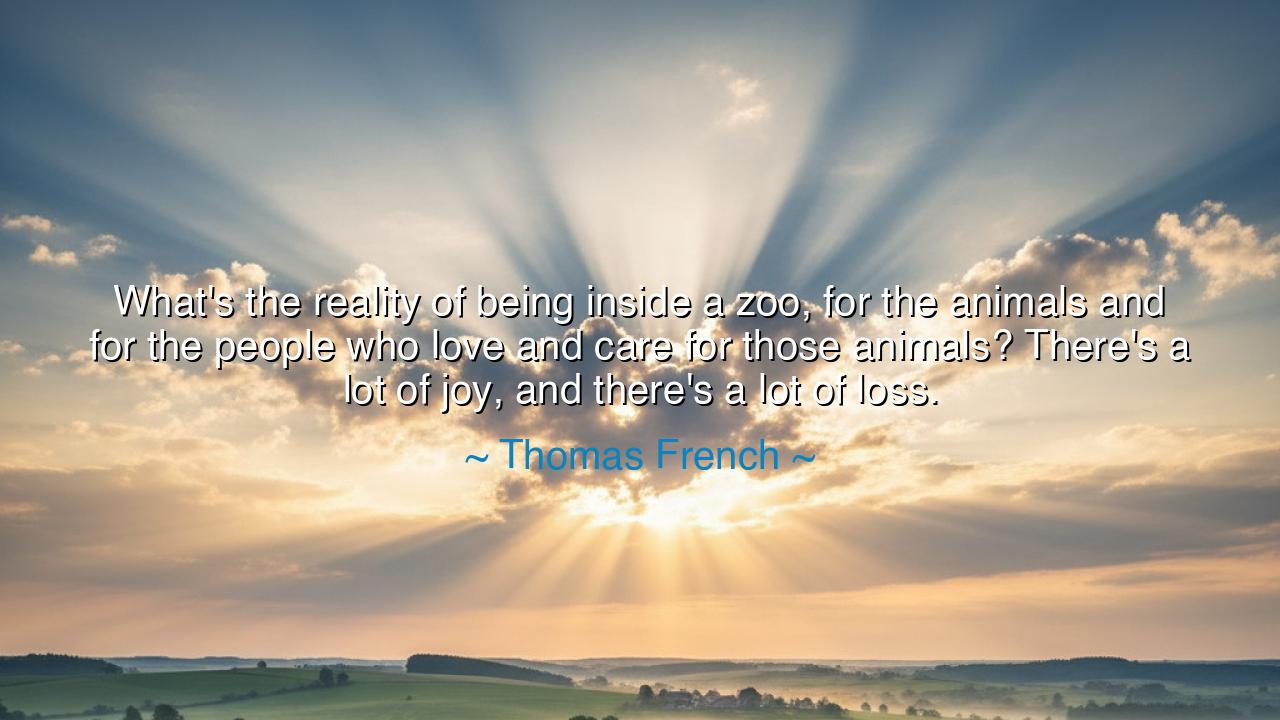
What's the reality of being inside a zoo, for the animals and for
What's the reality of being inside a zoo, for the animals and for the people who love and care for those animals? There's a lot of joy, and there's a lot of loss.






"What’s the reality of being inside a zoo, for the animals and for the people who love and care for those animals? There’s a lot of joy, and there’s a lot of loss." — thus spoke Thomas French, the chronicler of life’s fragile wonders, who peered beyond the bars of the zoo and saw not merely caged beasts, but a mirror of the human heart. In this single reflection lies the paradox of existence itself — that where there is love, there must also be loss, and where there is care, there must also be sorrow. For joy and grief are not enemies; they are companions, twined together like day and night, each giving meaning to the other.
French’s words spring from his deep exploration in Zoo Story: Life in the Garden of Captives, where he sought to understand the world behind the glass — the silent tension between human devotion and animal captivity. He beheld the keepers, those who dedicate their lives to nurturing lions, elephants, and apes, bound not by chains but by compassion. He also beheld the animals, whose eyes still remember the wild, even as they learn to live within walls. Between them exists a strange and beautiful bond — filled with tenderness, laughter, and trust — yet shadowed by longing, confinement, and death. In this sacred space, joy and loss walk hand in hand.
To understand this truth, one must look beyond the surface. The zoo, in its deepest meaning, is not only a place of observation; it is a sanctuary and a sorrow, a reflection of humankind’s desire both to protect and to possess. The keepers feel pride in their care — the feeding, the healing, the births that bring new life into the world. They rejoice when a sick creature rises again, when the roar of a lion echoes through the dawn. Yet they also bear the weight of grief — when illness comes, when an old friend dies, or when the captivity itself begins to gnaw at the spirit of the animal they love. Their devotion demands sacrifice, for to love deeply is to open the soul to inevitable heartbreak.
Consider the story of Dian Fossey, who devoted her life to the protection of mountain gorillas in the misty forests of Rwanda. She lived among them, learned their voices, and called them her family. Through her love, the world came to see these beings not as beasts but as kin. Yet her life was marked by both triumph and tragedy — the joy of connection and the agony of loss, as she witnessed the slaughter of her beloved gorillas at the hands of poachers. Her final act was not one of despair but of faith: to give her life so that others might live. In her story, as in French’s words, we see the same dual truth — that where love exists, loss becomes the proof of its depth.
There is also a deeper reflection here — one that touches the very essence of what it means to be human. We, too, are both keepers and captives. The cages we build for animals mirror the invisible cages we build for ourselves — cages of fear, of control, of guilt. Yet even within these walls, love finds a way to grow. The zookeeper’s tears for a dying elephant, the child’s awe at seeing a giraffe for the first time — these moments remind us that the heart’s capacity for empathy transcends boundaries. The zoo becomes a parable: a place where connection struggles against confinement, where compassion battles the consequences of human power.
French’s observation — “There’s a lot of joy, and there’s a lot of loss” — could be said of all creation. Every bond, whether between man and beast, parent and child, or friend and friend, carries both light and shadow. To love is to invite loss, and to lose is to prove that love was real. The keeper who mourns an animal’s death is not diminished by grief but enlarged by it, for sorrow is the echo of love’s greatness. Joy and loss are not separate forces but the two wings of devotion; without one, the other cannot fly.
So let this be the teaching: Do not fear love because it brings pain, nor shun care because it brings loss. The heart that refuses to love may protect itself from sorrow, but it will also close itself to wonder. Embrace the fullness of life — its laughter and its weeping — as the keepers do when they rise before dawn to tend their charges. Let your acts of love, however small, be your defiance against despair. Build sanctuaries in your life — not of walls, but of compassion.
And remember this final truth, passed down like an ancient proverb: Every joy we taste carries within it the seed of loss, but every loss, when borne with love, carries the promise of meaning. As Thomas French saw within the quiet world of the zoo, life is both gift and grief, sunlight and shadow. To love the world, in all its imperfection, is to stand courageously in that tension — to care, to weep, and to rejoice — knowing that it is the very mixture of joy and loss that makes the human spirit divine.






AAdministratorAdministrator
Welcome, honored guests. Please leave a comment, we will respond soon